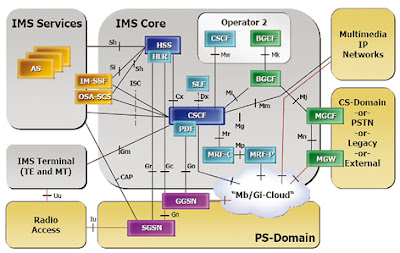IMS Overview and Architecure
The IP-Multimedia Subsystem (IMS) defines the functional architecture
for a managed IP-based network. It aims to provide a means for
carriers
to create an open, standards-based network that delivers integrated
multimedia services to increase revenue, while also reducing network
CapEx
and OpEx.
IMS was originally designed for third-generation mobile phones, but
it has already been extended to handle access from WiFi networks, and is
continuing to be extended into an access-independent platform for
service delivery, including broadband fixed-line access. It promises to
provide seamless roaming between mobile, public WiFi and private
networks for a wide range of services and devices.
The IMS architecture has been designed to enable operators to provide
a wide range of real-time, packet-based services
and to track their use in a way that allows both traditional time-based
charging as well as packet and service-based charging. It has become
increasingly popular both with wireline and wireless service providers
as it is designed to increase carrier revenues, deliver integrated
multimedia services, and create an open, standards-based network.
IMS provides a wide range of session border control, including call
access control, reachability and security. It also provides a framework
for the deployment of both basic calling services and enhanced services,
including
- multimedia messaging
- web integration
- presence-based services
- push-to-talk.
At the same time, it draws on the traditional telecommunications experience of
- guaranteed QoS
- flexible charging mechanisms (time-based, call-collect, premium rates)
- lawful intercept legislation compliance.
Network operators also hope that IMS will cut their CapEx and OpEx
through the use of a converged IP backbone and the open IMS
architecture.
- The IMS architecture defines many common components (for example, call control and configuration storage) so less development work is required to create a new service as this existing infrastructure can be reused.
- The use of standardized interfaces should increase competition between suppliers; preventing operators from being locked into a single supplier's proprietary interfaces.
As a result, IMS should enable new services to be rolled out more
quickly and cheaply, compared with the traditional monolithic design of
telephony services.

Comments
Post a Comment